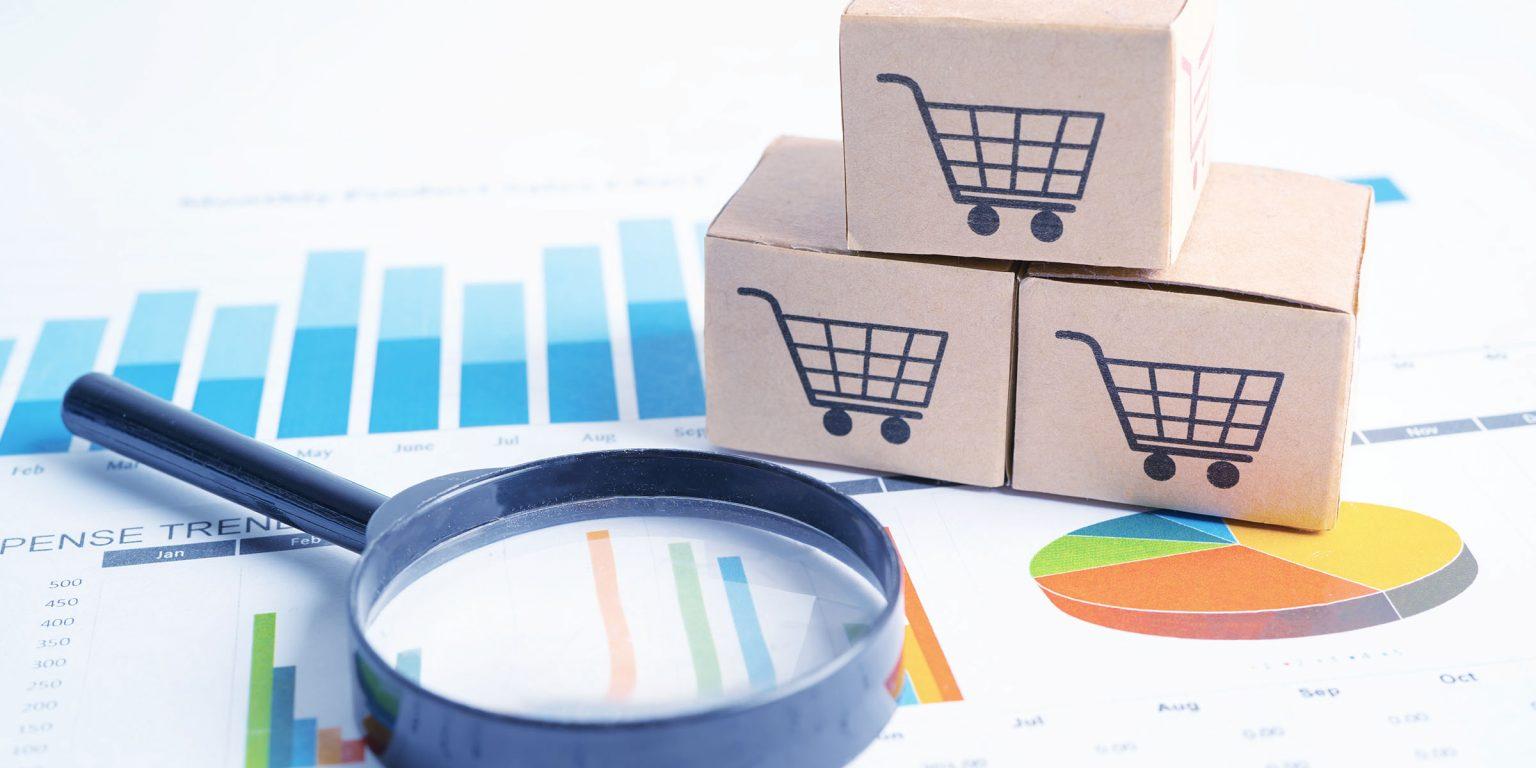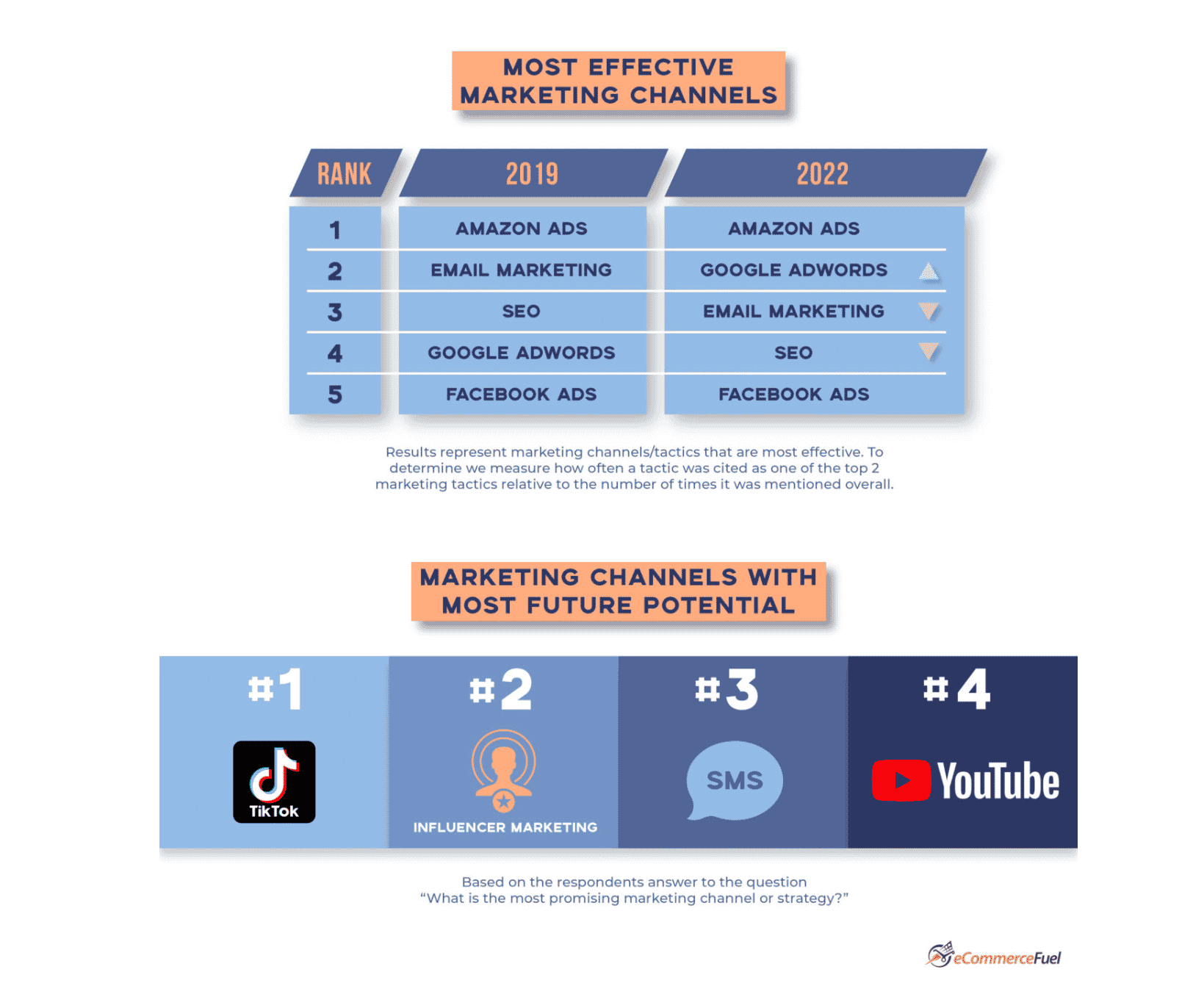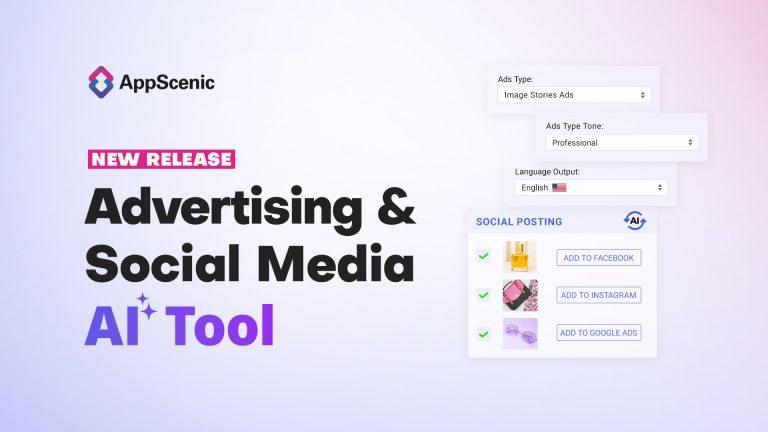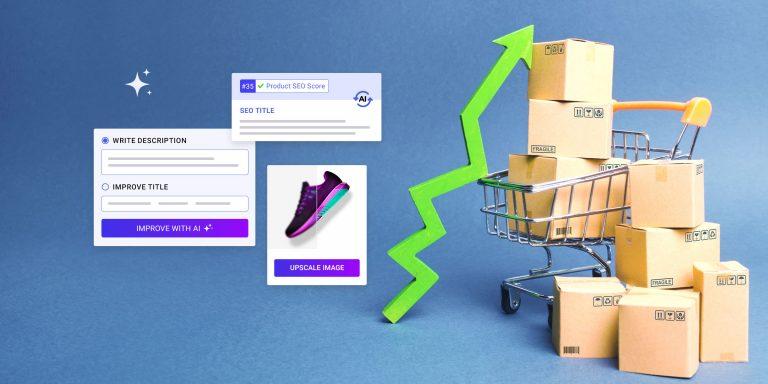Dropshipping and ecommerce are ever-changing, as is everything in the digital world. And so it can be quite difficult to keep up with the latest statistics and facts in these interconnected industries.
That’s why we thought what better way to help you keep track of all these than to gather the most important dropshipping statistics (of course, in our opinion) in one article so you have an overview of the latest trends in ecommerce.
This way you can see if you need to realign your strategy or keep up the good work.
Table of Contents
The global dropshipping market is expected to reach $201 billion in 2024 and $1,253 billion by 2030
Probably the most important dropshipping statistics to know right now comes from this recent study from Statista. According to them, it’s forecasted that the global dropshipping market size will reach $301 billion in 2024, and it will continue to grow, reaching $476.1 billion by 2026.
And, another report done by Grand View Research states that the dropshipping industry is expected to reach $1,253.79 billion by 2030, registering a CAGR of 23.4% over the forecast period.
Now, the same company just released a new report in 2024 stating the global B2C eCommerce market size is anticipated to reach $17,77 trillion by 2030. Check out the full report here.
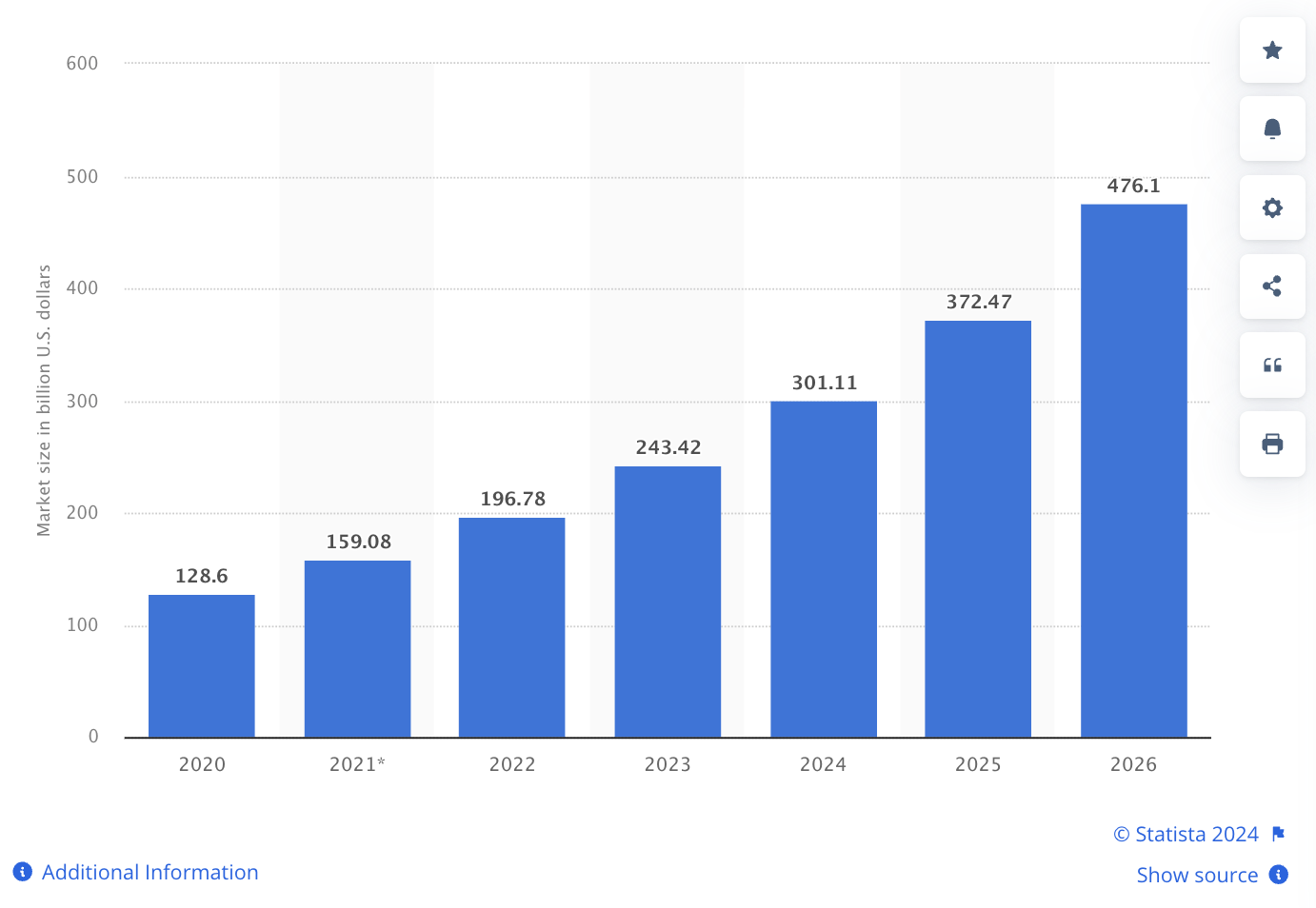
In other words, this fact proves that you made the right decision to invest your time, money and effort into a dropshipping business. This business model is clearly a very successful one and quite profitable. So give yourself a pat on the back.
27% of online retailers are now dropshipping
I guess if we consider all the data we’ve been adding here, this estimation isn’t such big news, isn’t it? It’s only normal that more and more online retailers want to give dropshipping a try now that it’s proven to be profitable and successful.
So, around 27% of online retailers are using the dropshipping business model as their primary method to fulfill orders from customers. And as a consequence of this, manufacturers and suppliers have also increased revenue coming from dropshipping. A win-win situation!
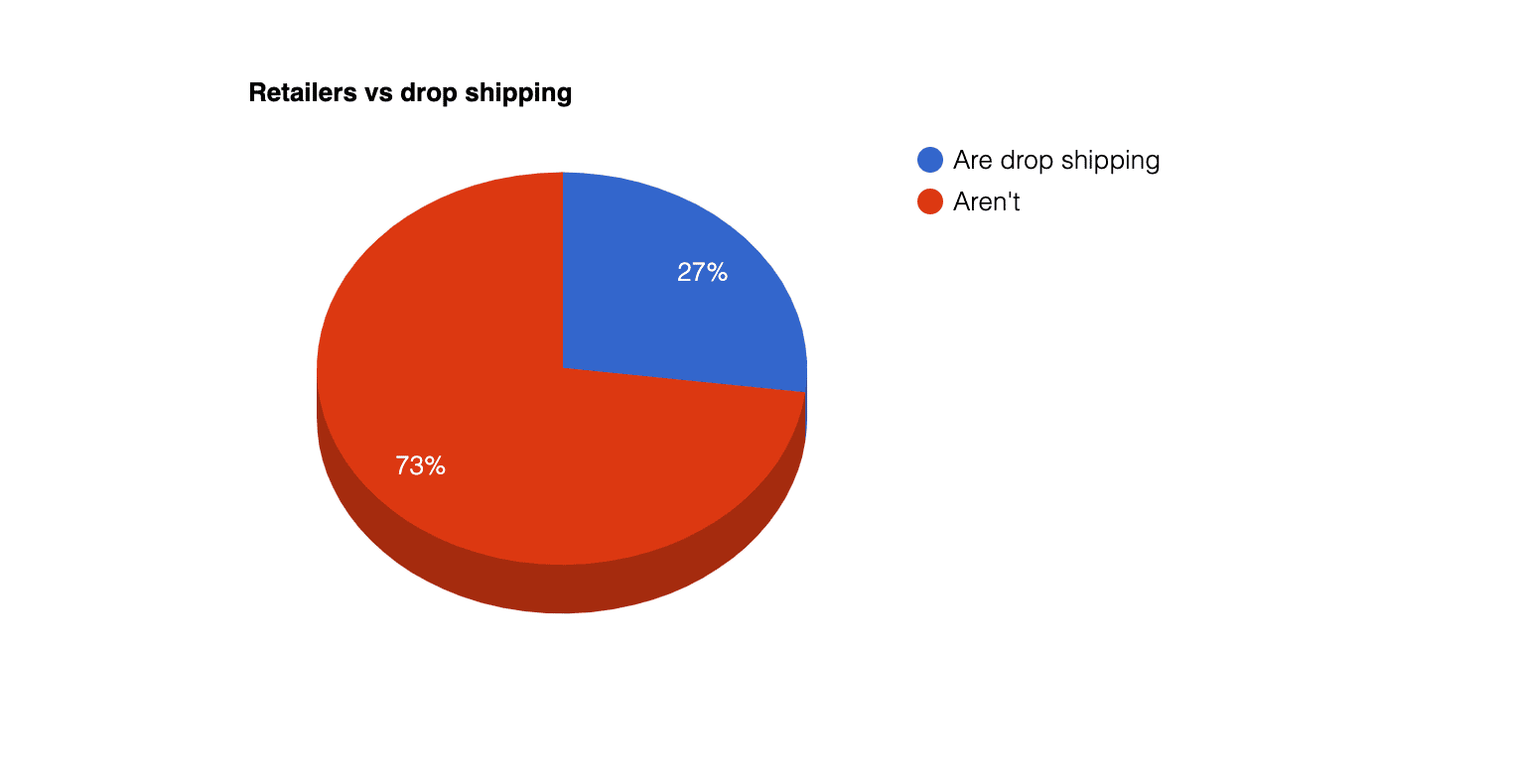
Who wouldn’t want to start an eCommerce business without having to worry about inventory or, as a supplier and manufacturer, not having to worry about a global customer base?
US ecommerce sales will grow in 2024
The US ecommerce market is set for steady growth, with projections showing that US ecommerce sales will grow by 8.7% in 2024, reaching nearly $1.2 trillion—a figure that accounts for 16.2% of total retail sales. (Source)
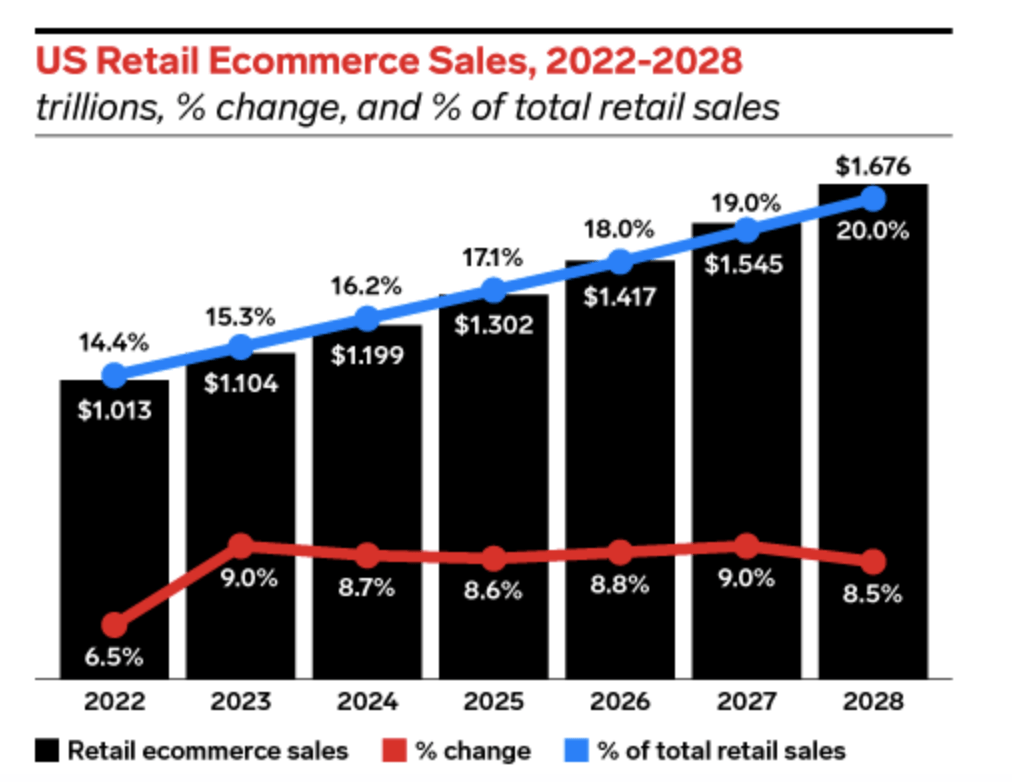
This trend reflects a significant shift in consumer shopping behavior, where the convenience of online shopping continues to outpace traditional in-store purchases. By 2028, ecommerce is expected to grow at more than four times the rate of in-store retail sales, highlighting the vast potential of the online marketplace.
The number of US online shoppers is steadily increasing
As of 2024, there are 273.49 million online shoppers in the United States, representing a 5.6% increase, according to a recent Statista study.
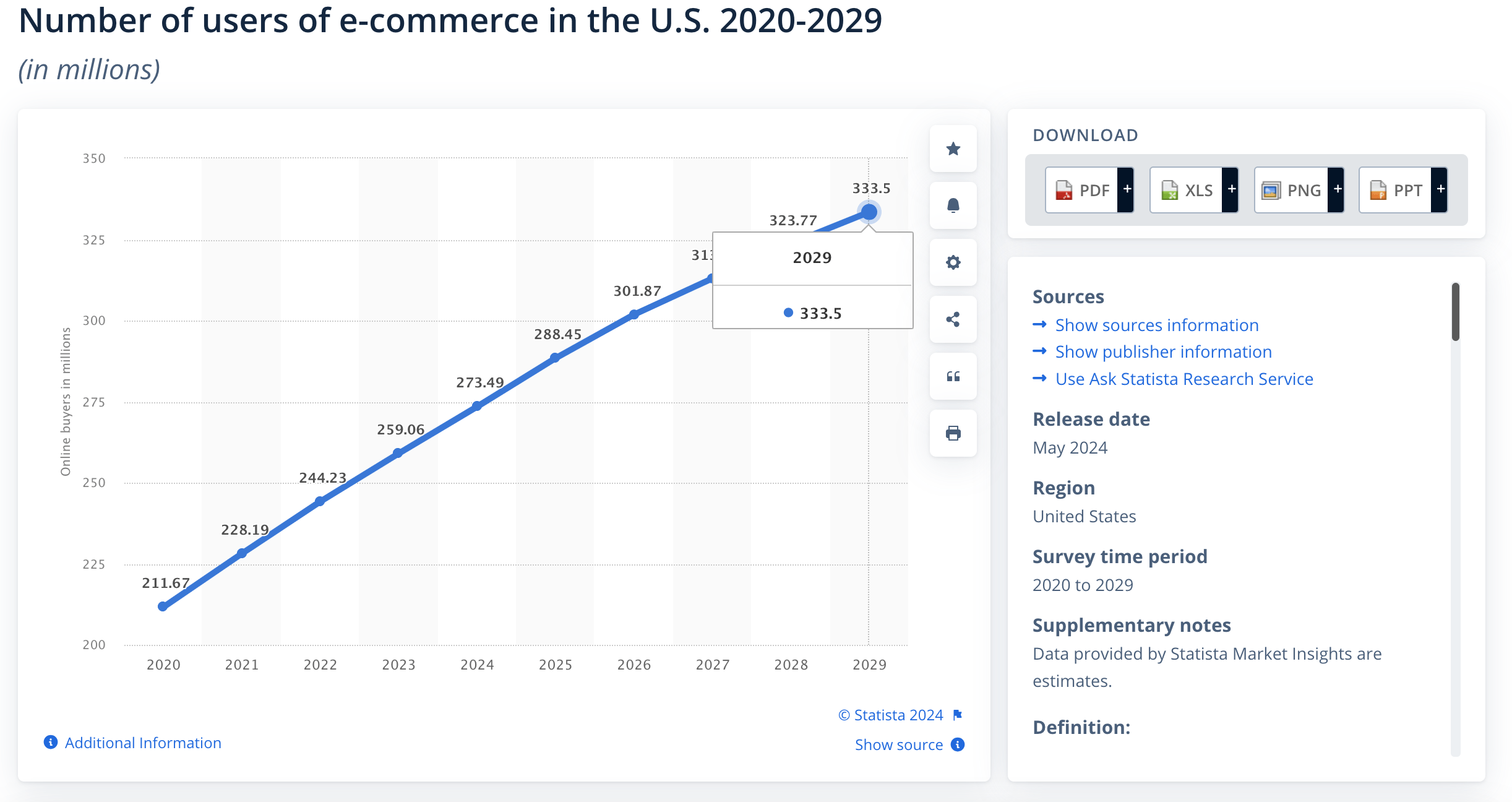
Here are some more key projections:
- 2025: The number of online shoppers is expected to grow to 288.45 million, adding nearly 15 million new digital consumers in just one year.
- 2026: A milestone year as the U.S. surpasses the 300 million online shopper mark, reaching 301.87 million.
- 2027: The number rises further to 313.01 million, reflecting the ongoing shift towards digital retail.
- 2029: The U.S. online shopping population is forecasted to hit 333.50 million, marking a significant increase in ecommerce adoption over the decade.
This steady rise in digital shoppers signifies unparalleled opportunities for dropshippers. With a growing customer base, businesses can tap into broader audiences by offering products tailored to emerging consumer preferences and leveraging data-driven marketing strategies.
Clothing is the most popular category for online purchases in the US
When it comes to online shopping trends in the US, clothing stands out as the most popular category for online purchases as of September 2024. A comprehensive survey of over 10,000 participants conducted between October 2023 and September 2024 reveals that 43% of U.S. consumers purchased clothing-related items online, making it the top choice among shoppers. (Source)
The apparel and accessories sector experienced a 5.6% growth in sales in 2023, solidifying its position as one of the fastest-growing consumer product categories in the U.S.
With this sustained growth, dropshipping clothing items—such as trendy outfits, seasonal wear, and unique fashion accessories—presents a profitable opportunity for ecommerce entrepreneurs looking to tap into this expanding market.
Read more: How to Start Dropshipping in the US
Asia Pacific is the fastest-growing dropshipping region
The Asia Pacific region is now the segment with the fastest growth rate globally in dropshipping. Dominating the market share, this region is expected to reach an impressive compound annual growth rate (CAGR) of 37.7% by 2031. Next up is North America, with its own impressive growth rate with a CAGR of 33.3%.
It’s clear that these regions are not just participating in the dropshipping game; they’re playing to win, showcasing just how popular and essential dropshipping has become in the global ecommerce scene.
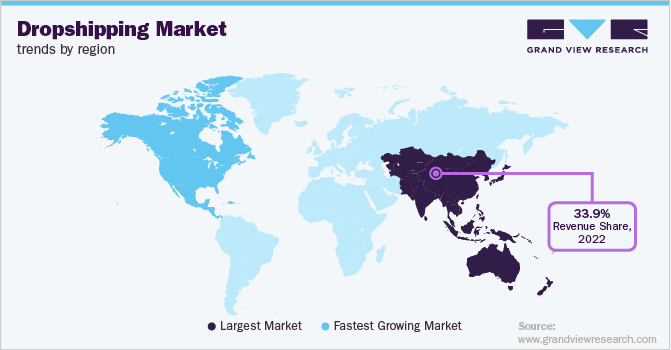
The average success rate of a dropshipping business is between 10% and 20%
According to top dropshippers around the web, it is estimated that only between 10% and 20% of dropshipping businesses succeed. Yet this doesn’t mean you won’t succeed, it only means there are many people that start this type of business without actually understanding what it’s all about.
This business model will not get you rich overnight, you need to work hard and be passionate about ecommerce and in time your business can be profitable and successful.
Beauty, health, personal, & household care are the leading sectors in the dropshipping market
According to Allied Market Research, the beauty, health, personal, and household care niches are the most common sectors where dropshipping is used. Actually, it seems that the food and personal care goods market is expected to grow at a 30% CAGR between 2019 and 2025.

Fashion is one of the strongest dropshipping niches
Yes, fashion is absolutely rocking the dropshipping world! At a compound annual growth rate (CAGR) of 35.6% by 2031, fashion is still one of the top niches to sell in 2024. By 2026, the fashion market size is expected to reach about $2 trillion.
What sets fashion apart from gadgets or food is that these items are highly customizable. This means that dropshippers can get creative more easily, designing one-of-a-kind products that not only stand out but also bring more profit.
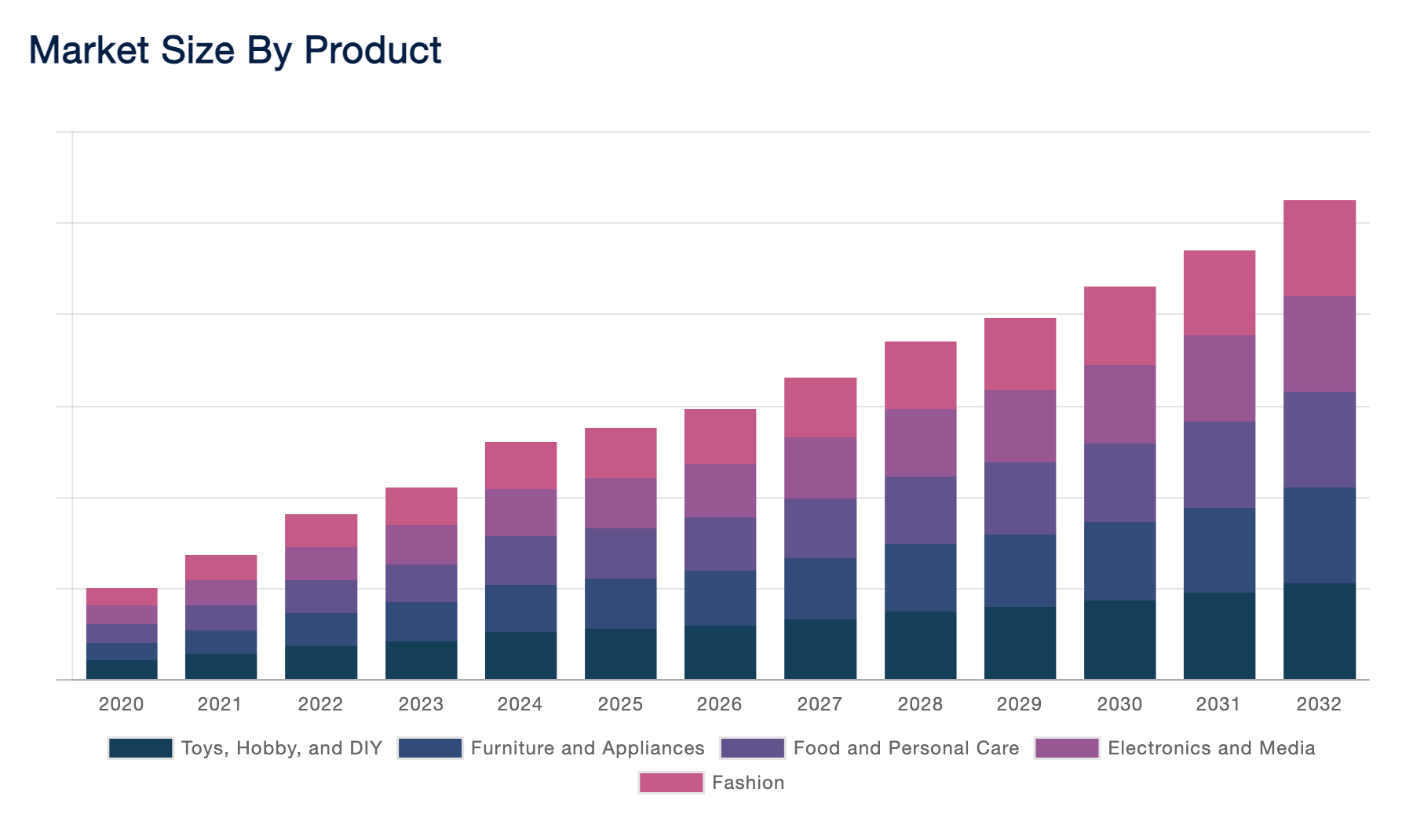
Dropshippers can make between 15%-20% profit margin
Dropshipping businesses typically have a healthy profit margin, with the average ranging between 15% and 20%. If your sales are over 10% above the wholesale price, you’re on a good path to securing a strong profit margin.
To get a clear picture of your dropshipping business’s profit margin, it’s crucial to factor in all costs. This can mean the dropshipping and e-commerce platform you use, shipping fees, or taxes, marketplaces, website hosting charges, and the budget allocated for marketing.
Considering these costs is essential when setting your product prices in your online store, so make sure you find the right balance between competitiveness and profitability.
Read more: The true cost of dropshipping
Suppliers make 18.33% more in profit when selling to dropshippers than through their own online shops.
Not only retailers or store owners can get huge financial benefits when dropshipping, but suppliers and wholesalers too. It seems that they get 18.33% more profit when they sell through dropshippers than when they sell the same product through their online stores.
So, we can say it’s a win-win situation when dropshipping for both suppliers and retailers.
There are 2.71 billion global digital buyers
In 2024, the number of digital buyers has reached 2.71 billion and it’s projected to reach 2.77 billion in 2025. And yes, the number of online shoppers has been growing in the past years. There are now 70 million more customers that prefer to buy online than in the last years, which is a 2.7% year-over-year increase.
84% of ecommerce retailers confirm that supplier selection is a top dropshipping obstacle
This is one statistic that can help you understand the challenges of starting dropshipping. 84% of ecommerce retailers say searching for a reliable supplier is the most significant obstacle in starting a successful dropshipping business.
Selecting the right third-party supplier is clearly an essential decision that needs thorough research. To avoid getting stuck, here are some tips:
- Examine the company’s history: Analise the supplier’s history and experience within the market. A well-known supplier with a proven track record is more likely to provide reliable service.
- More than price comparison: While comparing prices is crucial, don’t overlook other critical factors, such as shipping rates and delivery times. These aspects can significantly impact your customer satisfaction.
- Customer feedback matters: Pay attention to the experiences of other customers who have dealt with the supplier. Reviews and testimonials can provide valuable insights into the supplier’s performance and reliability.
- Quality assurance: Before choosing a supplier, request sample orders to test the quality of the products you want to sell. Making sure your product is high-quality is essential for building trust with your customers.
- Customization services: Consider whether the supplier offers customization services. This can be a valuable differentiator, as it will allow you to offer unique products that stand out in a competitive market.
Selecting a reliable supplier is a critical step in your dropshipping journey, as it directly impacts your business’s success and reputation.
By carefully evaluating potential partners using these guidelines, you can navigate the complex supplier landscape with confidence.
Read more: Top 5 things to consider before choosing a supplier
The global dropshipping market for fashion and apparel products will grow every year by 12.8%
According to a recent report by Technavio, the global dropshipping market for fashion and apparel products is expected to increase by $192.68 billion, at a CAGR of 13.31% between 2022 and 2027.
This growth is driven by the increasing popularity of ecommerce and the growing demand for fashion and apparel products. The report also highlights that the growing use of social media platforms and online marketplaces has made it easier for small and medium-sized retailers to enter the market and benefit from the dropshipping model, which allows them to offer a wide range of products without having to invest in large quantities of inventory.
Additionally, the report states that the ease of setting up and running an online store, and the lower overhead costs compared to traditional brick-and-mortar stores, have also contributed to the growth of the dropshipping market for fashion and apparel products.
The home and garden niche in dropshipping is a $29.9 billion industry
According to a report by ResearchAndMarkets, the global dropshipping market for home and garden products was valued at $29.9 billion in 2020 and is projected to grow at a Compound Annual Growth Rate (CAGR) of 12.3% from 2020 to 2028.
61% of retailers are making their ecommerce platform a budget priority
According to this report, 61% of B2B retailers plan to make their eCommerce platform a top technology budget priority in the next year.

More key data from the same report:
- 18% of retailers are looking to switch ecommerce platforms
- 39% of retailers said that investment in ecommerce platforms improved conversions
- 71% of retailers who intend to invest more in ecommerce technology this year said they want to do this to attract new customers
- 42% of retailers said they’ve been using the same ecommerce platform for more than five years
- 12% of retailers say they are most likely to choose “headless commerce” technology for their next ecommerce platform.
Ecommerce sales are estimated to reach $7.4 trillion by 2025
According to Statista, retail ecommerce sales have reached approximately $5.8 trillion worldwide in 2023. But what’s even more amazing is that they will keep on growing over the next four years.
It’s estimated that ecommerce sales will grow by 39%, reaching approx. $7.4 trillion by 2025. Now, isn’t that the greatest news of all?!?
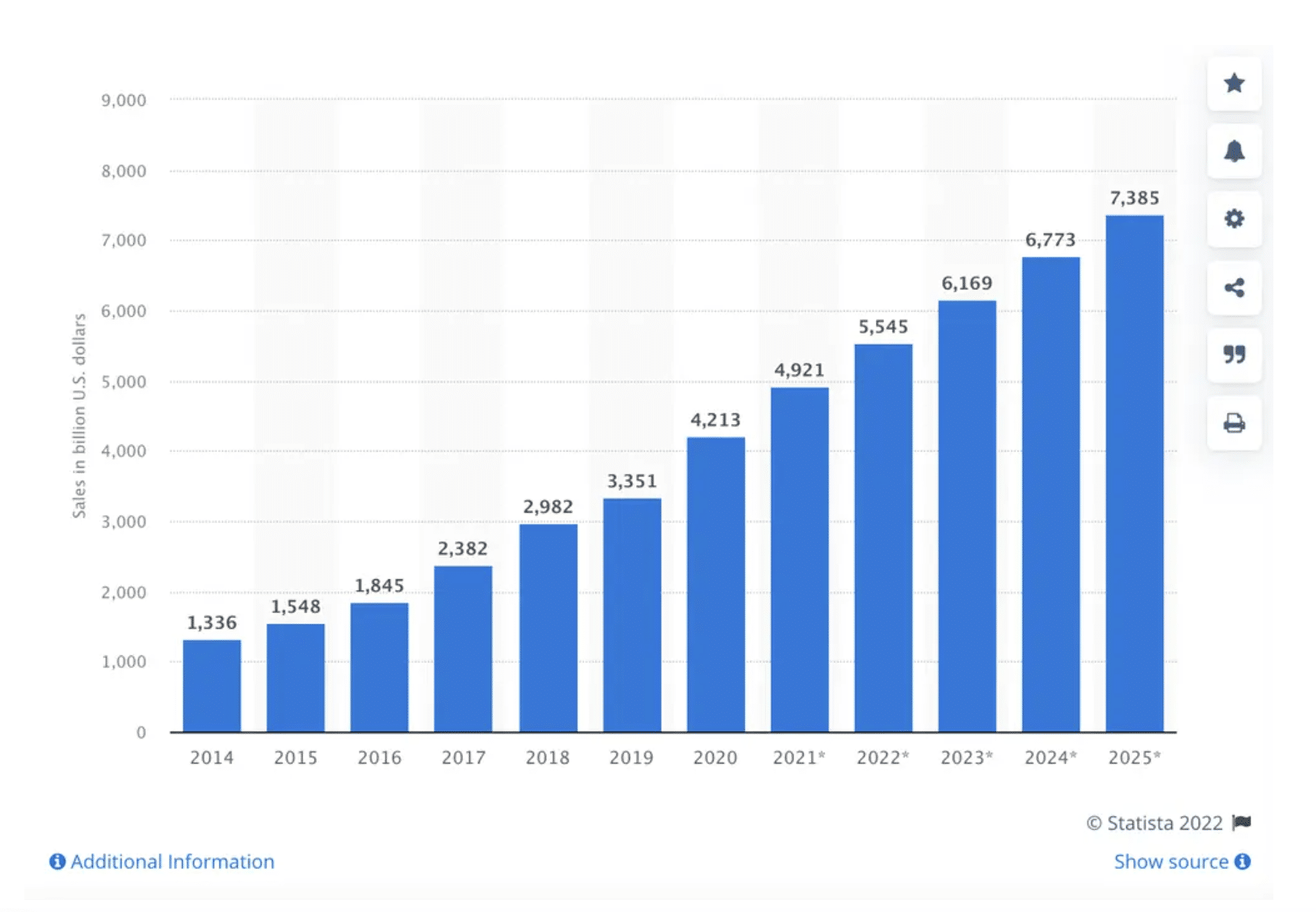
Online sales on B2B ecommerce sites, log-in portals and marketplaces increased to 17% in 2023
That’s what the 2024 B2B Market and Customer Experience Report states. It seems that in 2023, B2B online sales, log-in portals and marketplaces increased to $2.082 trillion from $1.39 trillion in 2020. All this means that in 2023, the combined ecommerce sales of manufacturers, distributors/ wholesalers, and retailers that sell online primarily to a business grew by 17%.
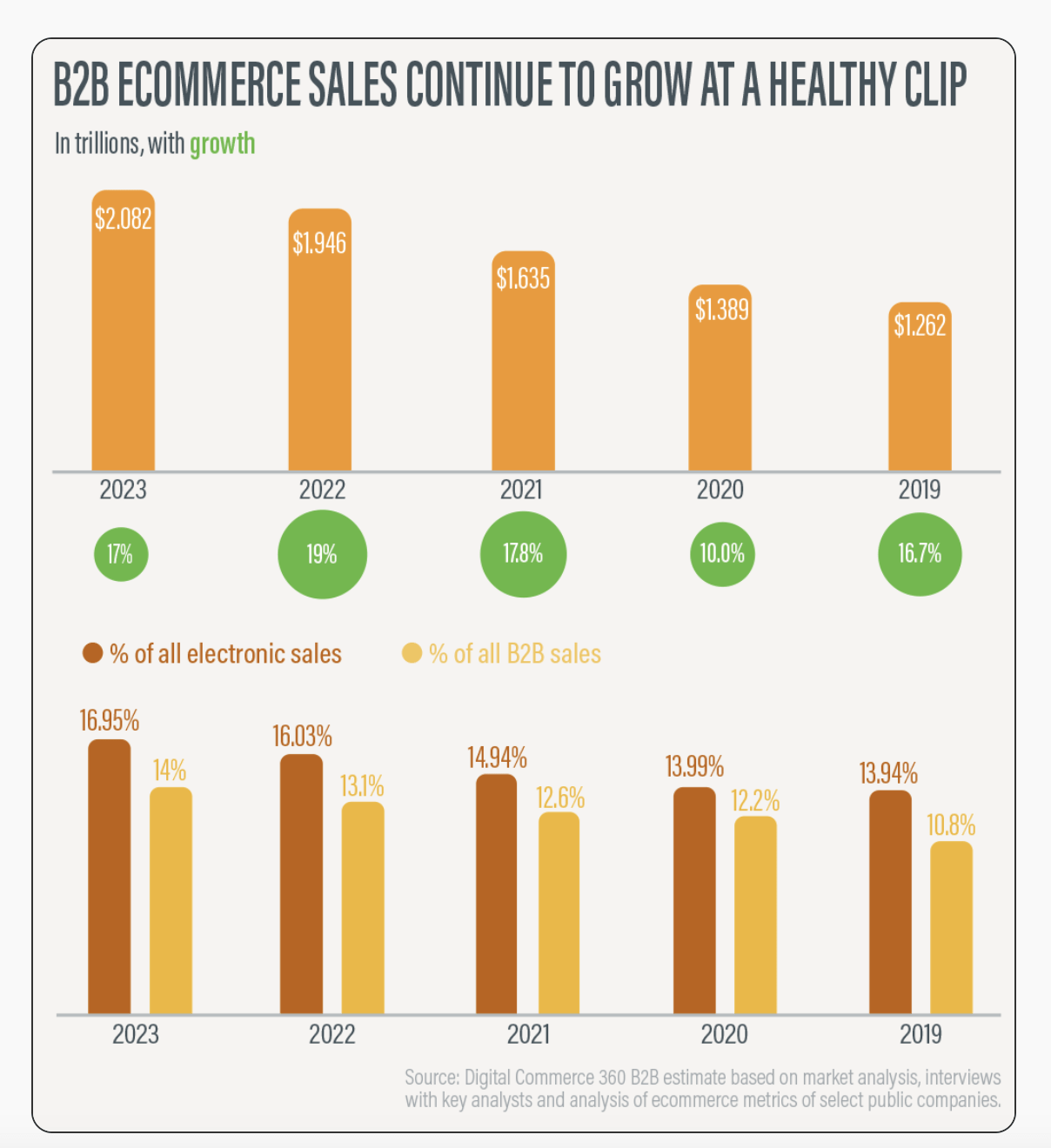
Key data from the same report:
- In 2023, the combined sales of U.S. manufacturers and distribution companies were flat at $14.87 trillion
- 7 of 10 B2B buyers see online buying as more convenient and prefer to do so when ready to buy
- In 2024, B2B ecommerce buyers will use anywhere from three to ten digitally driven channels to research purchases of goods and services and buy online from sellers
- B2B marketplace sales grew year over year by 100% in 2023.
China, the USA, Japan and the UK are the biggest ecommerce markets in 2024
It’s no surprise that China continues to be the biggest ecommerce market in 2024. But did you know that the USA came in 2nd place and Japan now comes in 3rd place before the UK?
So now you know which regions and countries are the top markets. Of course, this also means the competition in these markets is very high.
Mobile ecommerce accounts for 45% of all retail ecommerce sales in the USA
Insider Intelligence latest statistics forecast that US mobile ecommerce will double its total retail sales between 2020 and 2025.
If in 2021 mobile ecommerce sales meant $359.32 billion, it’s estimated that retail mobile ecommerce sales will reach $728.28 billion and account for 44.2% of retail ecommerce sales in the USA.
In 2023, ecommerce accounted for 19% of all retail sales worldwide
In 2023, ecommerce accounted for over 19% of retail sales worldwide. What’s even more exciting is that ecommerce sector is expected to make up close to a quarter of total global retail sales. So it keeps on increasing or, as retailers like to joke, ecommerce is starting to take over the world.
Joking aside, these statistics show that ecommerce has now got to such a point that it can’t be ignored anymore. It’s now becoming an important part of the consumer experience worldwide and it’s expected to influence even the retail industry.
33% of consumers have higher expectations for fast shipping
The pandemic has changed the way consumers thought about online shopping, as expected. And now, many of them expect not only that they will get their products faster but also that they can have the shipping for free.
So keep that in mind when starting a new store or finding ways to attract new customers.
83% of consumers discovered new brands online
Yes, that’s true. It seems that 83% of responders in this Ecommece Shopping Report said they often discover new brands online and that what most attracted them to that brand were: discounts and promotions (53%), great photos or videos (43%), website placement (33%), digital ads (33%) and influencer recommendations or reviews (23%).
Millennials shop online more than other groups in the USA
This is another statistic that we guess didn’t take you by surprise. We all know how digital-savvy those born between 1981 to 1996, the Millennials, are.
Well, now there is another survey that proves all this. 38.4% of online shoppers in the USA are under the age of 35. Only 14.4% of the people shopping online in the USA are 65 and above.
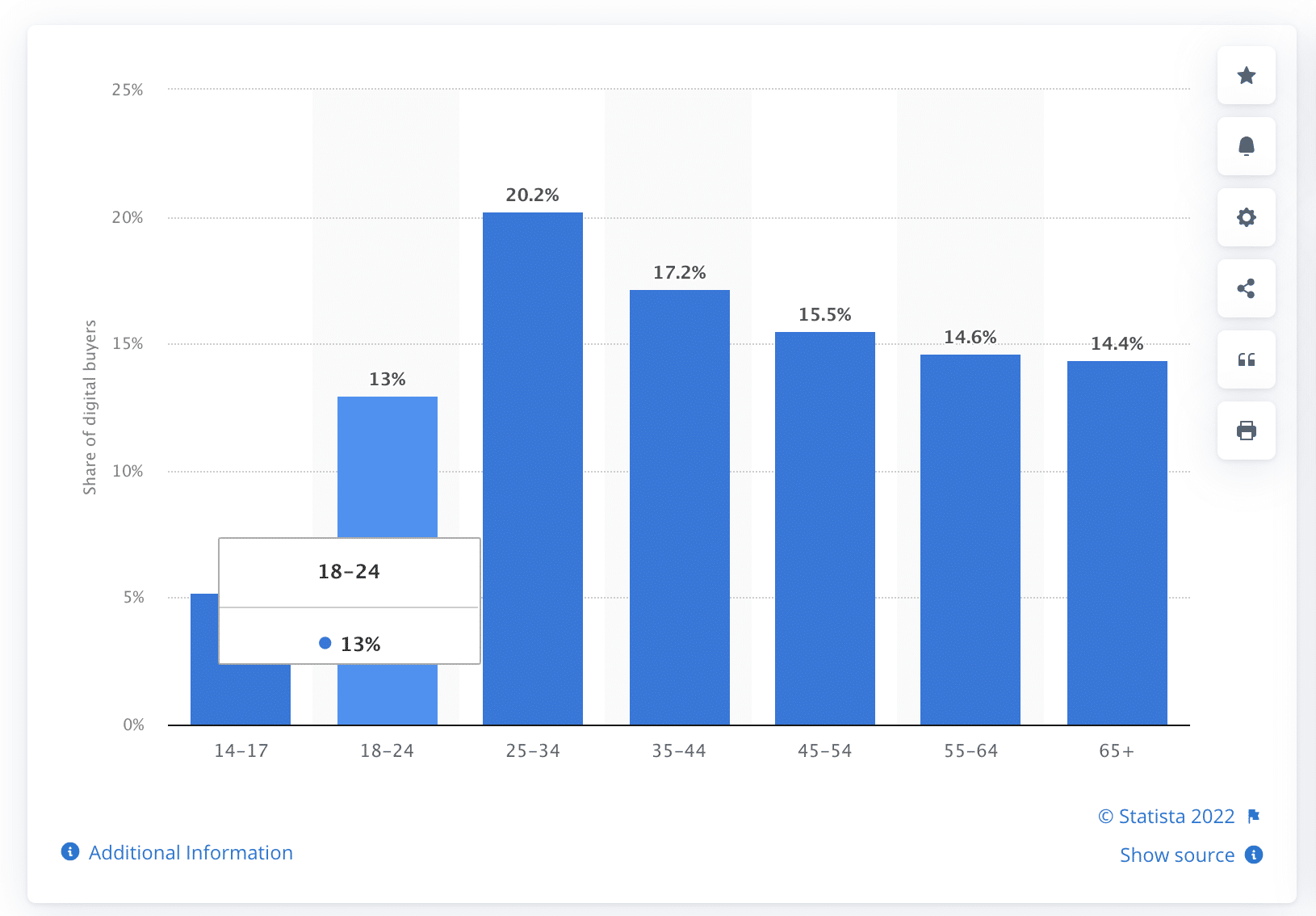
Shopify is the most used ecommerce platform
As of January 2024, Shopify is the most popular e-commerce platform according to Built With. It’s now used by over 23% of the top-performing stores worldwide. As expected, WooCommerce, a WordPress plugin that will transform your website into an ecommerce one, is the 2nd most used tool.
45% of the stores use other platforms, such as Magento, OpenCart, Presta Shop, Squarespace, BigCommerce, or Wix.
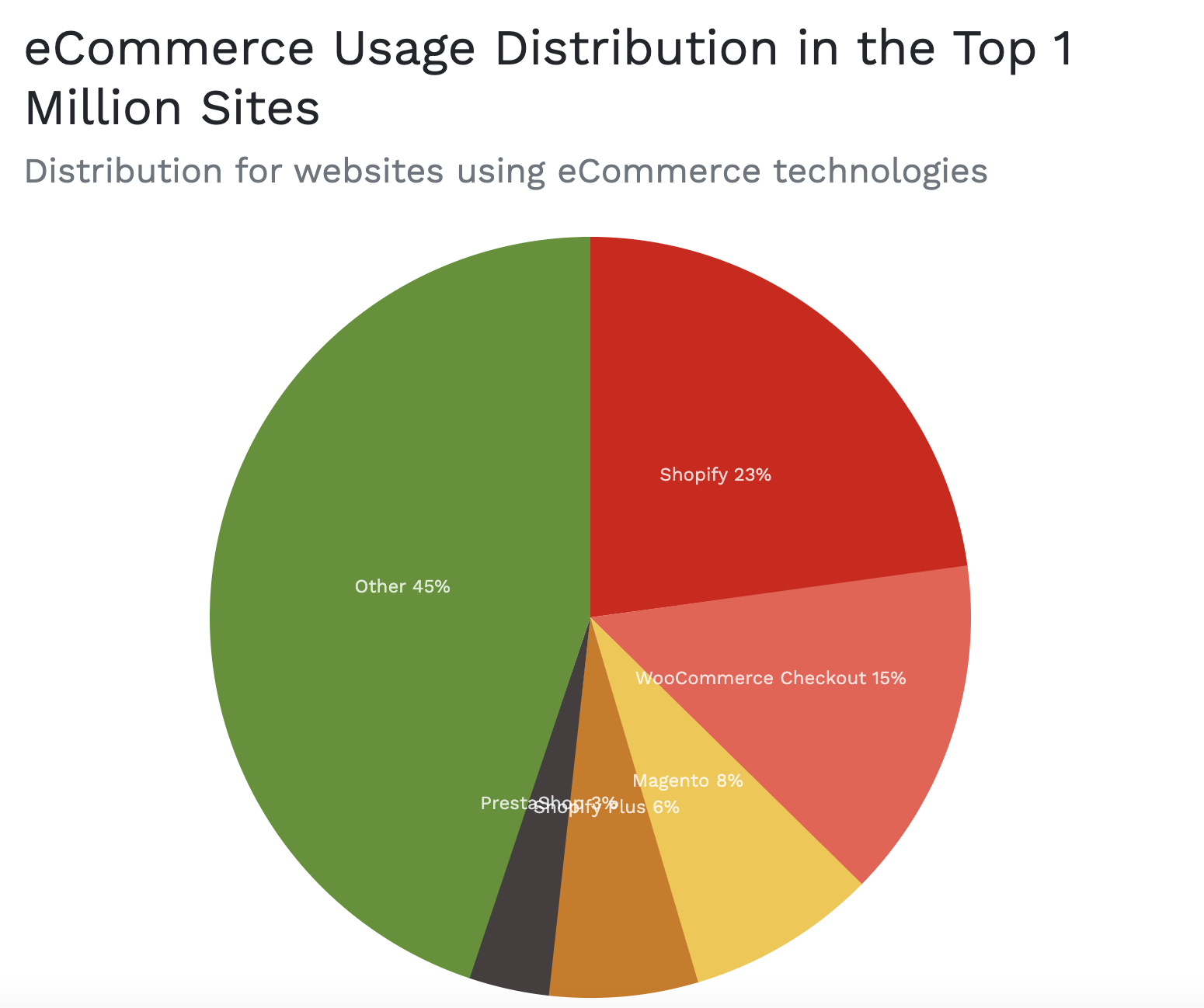
Now, both platforms are great, with their pros and cons. That’s why online store owners need to do in-depth research about each of them and find out which one better fits them.
Read more about Shopify vs WooCommerce
Online stores that have at least one social media channel have an average of 32% more sales
According to the latest ecommerce statistics done by BigCommerce, online stores with at least one social media account (Facebook and/or Twitter) have, on average, 32% more sales than those not using these social media channels.
Well, if this data didn’t convince you to create a Facebook page, then we don’t know what it will be. This data clearly states that having at least one social media channel should be a must in your marketing strategy.
Now you know that being on social media means more than brand awareness or a new source for generating more traffic to your online store. It will also bring you more sales, which is what we all want, right?
TikTok and influencer marketing are the most promising channels for marketing
Influencer marketing is gaining more and more popularity as brands understand that SEO and other social media channels are becoming more crowded and expensive. That’s why it’s no surprise that brands are turning more to content creators to promote their products and give credibility to their brand stories.
The primary reason for abandoned carts has to do with unexpected shipping fees
As a store owner, you will definitely want to know why your customers abandoned their carts and don’t get to make an actual order.
Well, it seems that the latest available data shows that the top reason customers abandon their carts has to do with shipping fees that cost more than they predicted.

Other reasons for abandoned carts include discount code that doesn’t work, order taking too long to be shipped, having to re-enter credit card details and having to re-enter shipping details.
42% of shoppers expect a 2-day shipping option available
Here’s what a consumer survey done by Ware2Go revealed:
- 33% of consumers have higher expectations for fast shipping
- 40% of shoppers have higher expectations for free shipping
- 42% of shoppers expect a 2-day shipping option for every online purchase they make
All the above means that fast shipping, such as Prime delivery, next-day and same-day delivery, is a must to have for your online store. Customers are willing to even pay extra just to make sure they have the item delivered as fast as possible.
It’s decided: the top reason people shop online is free delivery
According to a survey done by Jungle Scout on 1,000 US consumers to learn why they chose online shopping, free shipping is the reason number 1.
Did that surprise you? We weren’t, to be honest.
Actually, it’s normal that this happened if we think about how this last year was, the whole pandemic situation has changed, maybe forever, old habits.
In the same study, 43% of consumers said they would be okay if they could never shop in a physical store again, and 73% even believed that shopping would happen online in the future.
So, keep in mind that offering free shipping may make a difference to your customers, and this can be why they choose you and not your competition.
You only have 15 seconds to get the attention of your customers
Maybe some of you already know it, but we wanted to also have in this article some real facts that can help set up an online store based on dropshipping.
The 15-second rule actually says that if you can’t get your customers excited in the first 15 seconds since they open your ecommerce store, then you will lose them.
So, if you want to have a better chance at keeping your customers on your website with the hopes that they will make a purchase, you should keep in mind the following:
- The looks – your ecommerce store should have a clean and beautiful design with clear information about your products. In other words, should be relevant for your target audience and easy to navigate through.
- The tech – if your ecommerce website doesn’t load in a max. of 3 seconds, then most likely your customers will exit even before seeing what you have to offer. Speed matters in this world – people don’t wait anymore. So, be sure that your website loads as fast as possible. Also, don’t forget to secure your payments transactions, security is something you should care about a lot these days.
- The products – to have a better chance at making a name for yourself as a store owner, you need the right products for the right people. So, we recommend selling high-quality and unique products that come with eye-catching images. After choosing the products you want to dropship, don’t forget to do some search engine optimization for each of them, this will help customers find your products faster.
Consumer reviews are trusted 12 times more than the manufacturer’s descriptions
We think this data is absolutely amazing and may be one of the most important statistics ever published. Now that you know how important it is for your customers to have reviews on your online store, you can do something about it.
In a way, it’s normal that consumers trust other people’s testimonials about your products more than anything else on your store or blog. Before becoming your customer, they need reassurance that a product looks and does what it’s supposed to do. It’s normal to have doubts about it, they can’t see, touch, or try it before purchasing, so they rely on other people’s experience with it.
So, be sure to make it easy for your existing customers to come back after they make a purchase and write a review about that product. That way you can include as many reviews as possible in your online store.
The business model and operational efficiency are the secrets of successful brands
According to this study, successful stores were 6x more likely to say that “Branding and Storytelling” gave them a competitive advantage and 77% more likely to the fact that they manufactured their own product.
And operational efficiency has a large impact too, as these top brands were 25% more likely to outsource warehouse operations and 25% less reliant on paid traffic.
More dropshipping statistics to come
Now, as you just read, dropshipping is blowing up right now and there are still many opportunities for people to start their own online businesses. According to these stats and facts we just shared, it looks like the industry is only going to keep growing.
With more and more people shopping online, this is the time to get in on the action and make some money. And dropshipping is clearly the easiest way you can do that!
If you’re into dropshipping and want to stay in the loop with all the latest trends and facts, don’t forget to save this article and check back regularly. We’ll be keeping it fresh with new stats every month.


